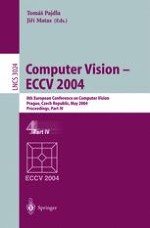2004 | OriginalPaper | Buchkapitel
On the Significance of Real-World Conditions for Material Classification
verfasst von : Eric Hayman, Barbara Caputo, Mario Fritz, Jan-Olof Eklundh
Erschienen in: Computer Vision - ECCV 2004
Verlag: Springer Berlin Heidelberg
Enthalten in: Professional Book Archive
Aktivieren Sie unsere intelligente Suche, um passende Fachinhalte oder Patente zu finden.
Wählen Sie Textabschnitte aus um mit Künstlicher Intelligenz passenden Patente zu finden. powered by
Markieren Sie Textabschnitte, um KI-gestützt weitere passende Inhalte zu finden. powered by
Classifying materials from their appearance is a challenging problem, especially if illumination and pose conditions are permitted to change: highlights and shadows caused by 3D structure can radically alter a sample’s visual texture. Despite these difficulties, researchers have demonstrated impressive results on the CUReT database which contains many images of 61 materials under different conditions. A first contribution of this paper is to further advance the state-of-the-art by applying Support Vector Machines to this problem. To our knowledge, we record the best results to date on the CUReT database.In our work we additionally investigate the effect of scale since robustness to viewing distance and zoom settings is crucial in many real-world situations. Indeed, a material’s appearance can vary considerably as fine-level detail becomes visible or disappears as the camera moves towards or away from the subject. We handle scale-variations using a pure-learning approach, incorporating samples imaged at different distances into the training set. An empirical investigation is conducted to show how the classification accuracy decreases as less scale information is made available during training. Since the CUReT database contains little scale variation, we introduce a new database which images ten CUReT materials at different distances, while also maintaining some change in pose and illumination. The first aim of the database is thus to provide scale variations, but a second and equally important objective is to attempt to recognise different samples of the CUReT materials. For instance, does training on the CUReT database enable recognition of another piece of sandpaper? The results clearly demonstrate that it is not possible to do so with any acceptable degree of accuracy. Thus we conclude that impressive results even on a well-designed database such as CUReT, does not imply that material classification is close to being a solved problem under real-world conditions.
